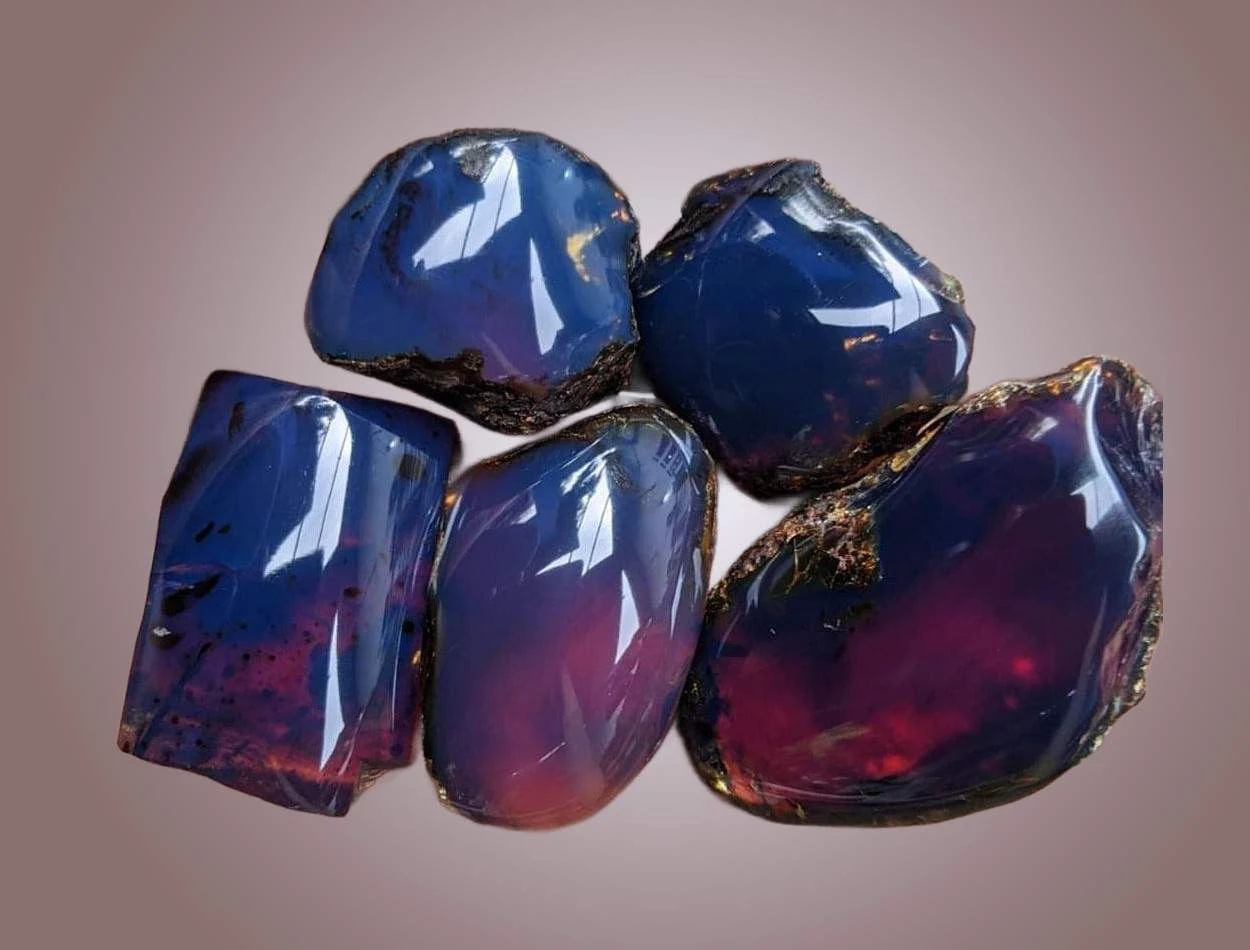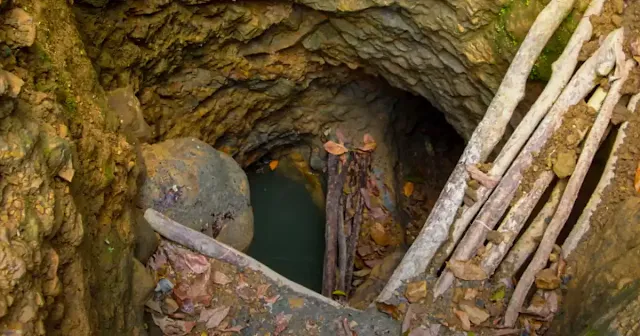Blue Amber: Rare Amber Variety
Blue amber is a rare variety of amber that exhibits a blue fluorescence under ultraviolet light or sunlight. While it appears yellow or brown under normal light, it glows with a unique blue hue when exposed to specific wavelengths.
Blue Amber, also known as Dominican Amber or Azullite, is a rare and fascinating gemstone prized for its unique color and potential metaphysical properties.
Blue Amber can be quite expensive. Due to its rarity and unique beauty, blue amber can be quite valuable, often fetching higher prices than other amber varieties.
Amber is a beautiful, fossilized resin from extinct conifer trees. It's not a mineral or a crystal, but an organic material with unique properties. Amber formed millions of years ago when the sticky resin oozed from conifer trees, often triggered by injuries or insect attacks.
 |
| Blue Amber |
How is Blue Amber Formed
Blue amber, like other types of amber, is formed from the fossilized resin of ancient trees. The process of amber formation involves several steps over millions of years:
Tree Resin Production: The process begins when certain types of trees produce resin. Resin is a sticky substance that the tree releases as a defense mechanism against insects, fungi, and other potential threats.
Trapping Inclusions: As the resin flows down the tree's bark, it can trap and encase various organic and inorganic materials, such as insects, plant matter, or even small animals. These inclusions are often preserved in the amber and provide valuable insights into ancient ecosystems.
Polymerization: Over time, the resin undergoes a process known as polymerization. This involves the transformation of the sticky, liquid resin into a more solid and stable material. Polymerization occurs through the loss of volatile components and chemical changes within the resin.
Burial and Sedimentation: The resin, now transformed into a semi-solid substance, may fall to the forest floor or be washed into rivers and seas. Over time, layers of sediment cover the resin, burying it underground.
Pressure and Heat: As more sediment accumulates over the resin, it experiences increasing pressure and temperature. The combination of pressure and heat helps to further harden the resin and eventually transform it into amber.
For blue amber specifically, the blue color is not inherent to the resin itself but is a result of fluorescence.
 |
| Polished Blue Amber |
What causes amber to be Blue
The distinctive blue color observed in some amber samples, particularly those from the Dominican Republic, arises from a photoluminescent phenomenon known as fluorescence. This phenomenon occurs due to the specific chemical composition of the amber and its interaction with ultraviolet (UV) radiation.
This phenomenon occurs due to the presence of specific polycyclic aromatic hydrocarbons (PAHs) within the fossilized resin matrix.
Upon exposure to ultraviolet (UV) radiation, these PAHs undergo electronic transitions from their ground state to an excited singlet state. As the excited state is energetically unstable, the molecules return to the ground state, releasing the absorbed energy in the form of visible light. Notably, the emitted light possesses a longer wavelength compared to the absorbed UV radiation. In blue amber, this transition falls within the blue region of the visible spectrum, resulting in the observed blue fluorescence.
It is crucial to recognize that not all amber containing PAHs exhibits blue fluorescence. The specific types and spatial arrangements of these molecules, in conjunction with other unidentified contributing factors, significantly influence the occurrence and intensity of the phenomenon. Additionally, the blue fluorescence is primarily confined to the surface of the amber specimen due to the limited penetration depth of UV radiation within the material. This results in the characteristic observation of blue fluorescence under UV illumination contrasting with the typical yellow to brown coloration under normal visible light.
In conclusion, the blue color characteristic of certain amber varieties stems from the fluorescence of specific PAHs embedded within the fossilized resin matrix. This phenomenon arises from the absorption of UV radiation followed by the emission of visible blue light, and its manifestation depends on various factors including the specific types and arrangements of the PAHs present.
 |
| Dominican blue amber |
Blue Amber Properties
Composition: Like all amber, blue amber is a fossilized resin from ancient trees. It is primarily composed of succinic acid, with trace amounts of other organic compounds.
Color: Blue amber ranges in color from a deep, rich blue to a lighter, greenish blue. The blue color is not caused by a pigment, but rather by fluorescence, a phenomenon where the material emits light when exposed to ultraviolet radiation.
Transparency: Blue amber can be transparent, translucent, or opaque.
Luster: Resinous, vitreous.
Streak: White or pale yellow.
Hardness: Blue amber has a hardness of 2.5 to 3 on the Mohs scale, which means it is relatively soft and can be scratched by a fingernail or a piece of glass.
Fluorescence: Blue amber has a strong blue fluorescence under ultraviolet light. This is caused by the presence of a fluorescent organic compound called succinite.
Specific gravity: Blue amber has a specific gravity of 1.05 to 1.10.
Inclusions: Can contain air bubbles, plant material, insects, and other organic matter.
 |
| Rough Blue Amber - Dominican Republic |
Where to find Blue amber
Blue amber, with its captivating blue fluorescence, can be found in a few select locations around the world:
Dominican Republic: This island nation boasts the largest concentration of blue amber, particularly in the mines around the city of Santiago and the eastern half of the country. It's considered the primary source of high-quality blue amber.
Mexico: Smaller deposits of blue amber exist in the Chiapas region of Mexico. These stones tend to have a slightly different fluorescence, often appearing more violet-blue compared to the Dominican variety.
Myanmar: While less common, blue amber can also be sourced from Myanmar. These stones share similar characteristics to Dominican amber but might have subtle variations in color and fluorescence intensity.
Indonesia: Indonesia is known for being one of the few places in the world where blue amber is found. The blue variety of amber is quite rare, and it is particularly associated with the mines in the Meru Betiri National Park in East Java, Indonesia. This region is recognized for producing amber that exhibits a striking blue-green fluorescence when exposed to ultraviolet light.
 |
| Blue Amber mine, Dominican Republic. |
Blue Amber FAQs
Is blue amber real amber?
Yes, blue amber is real amber! It's formed from the fossilized resin of extinct trees, just like other types of amber. The key difference lies in the presence of specific organic molecules within the resin that cause it to fluoresce blue under ultraviolet light or sunlight.
Is blue amber valuable?
Yes, blue amber is generally more valuable than regular amber. Blue amber is indeed considered valuable in the gemstone market. Its rarity, unique optical properties, and captivating blue-green fluorescence contribute to its high desirability among collectors, jewelry enthusiasts, and connoisseurs. The scarcity of blue amber, especially from specific locations where it is predominantly found, adds to its overall market value. The quality and intensity of the blue fluorescence, as well as the size and clarity of the gemstone, also influence its monetary worth.
Is blue amber fake?
Blue amber can be real, but fakes exist. Real pieces have natural blue fluorescence under UV light, are typically rare Dominican amber, and hold value. Fakes use treatments, synthetics, or dyes to mimic the look, lacking the true fluorescence and having different properties.
How to care for blue amber?
Caring for blue amber requires diligence:
Protect from heat and sunlight: Excessive heat and prolonged UV exposure can damage the amber and weaken the fluorescence. Store it in a cool, dark place.
Handle with care: It's a relatively soft gem (2-2.5 Mohs hardness), so avoid harsh impacts and scratches. Use a soft cloth for cleaning.
Avoid harsh chemicals: Solvents, alcohol, and cleaning products can damage the amber. Stick to warm water and a mild detergent for gentle cleaning.
Store wisely: Keep it separate from harder gemstones to prevent scratches. Ideally, wrap it in a soft cloth when not wearing it.
What are Blue Amber Metaphysical Properties?
Blue amber is believed by some to possess various metaphysical properties, although these beliefs are not scientifically proven. Some of the purported metaphysical properties associated with blue amber include:
Spiritual Protection: Blue amber is thought to offer protection against negative energies and psychic attacks, creating a shield of spiritual defense around the wearer.
Emotional Healing: It is believed to promote emotional healing and balance, helping individuals release past traumas, anxieties, and negative emotions.
Enhanced Intuition: Blue amber is said to stimulate the third eye chakra, enhancing intuition, insight, and spiritual awareness. It may facilitate psychic abilities and deepen one's connection to higher realms of consciousness.
Harmonizing Energy: Blue amber is believed to harmonize the energy field, promoting a sense of inner peace, tranquility, and alignment with one's true purpose.
Conclusion
Blue amber, with its captivating blue-green fluorescence, emerges as a gemstone that transcends traditional expectations. It is often used in the creation of exquisite jewelry pieces, including pendants, earrings, and rings, where its unique fluorescence adds an extra dimension of beauty and intrigue.


%20(1).webp)





